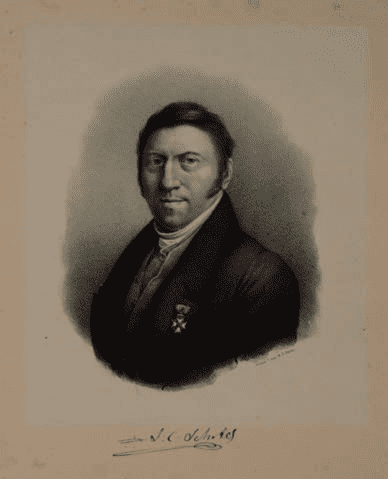
Portrait of Johannes Christianus Schotel
H. J. Backer
Lithography, 17 x 14.5 cm
Dordrecht, regionaal archief, inv.no. 551_11080
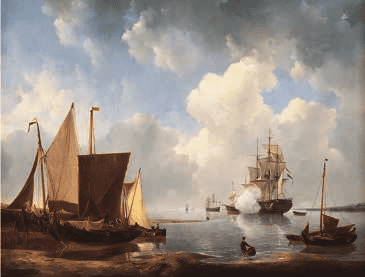
Johannes Christiaan Schotel
A calm
Oil on canvas: 125.5 x 165 cm
Dated: 1829
Haarlem, Teylers museum, inv.no. KS 004
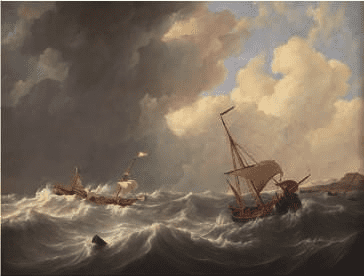
Johannes Christiaan Schotel
A tempest
Oil on canvas: 124.7 x 165.5 cm
Dated: 1825
Haarlem, Teylers museum, inv.no. KS 021
J.C. Schotel was the most important Dutch marine painter of the first half of the nineteenth century. He was highly esteemed and received many significant commissions, such as a pair of paintings (a storm and a calm) he created for the Teyler Stichting, Haarlem. they are of the highest quality and considered to be his best works.
The three paintings by J.C. Schotel presented here are of the same high quality and dated early in his oeuvre.
Unfortunately, Schotel’s later marines are usually far less competent. Presumably many of these later paintings were collaborations with his son P.J. Schotel (1808-1865).
In the work of J.C. Schotel we can see the influence of L. Backhuysen (1630-1708) and his drawings are sometimes still wrongly attributed to this seventeenth-century master.
J.C. Schotel was supposed to succeed his father as a factory owner but from childhood he was drawn to the sea. He was well educated; at an early age he discovered that he had a talent for drawing and took lessons from Adriaan Meulemans (1763-1835).
He was often found at the water’s edge observing passing ships and this encouraged him to become a sailor. His father could not agree with his son’s career choice and bought the boeier Apollo for him in 1804, on condition that he would abandon his travels and focus on trade. He became an experienced sailor and studied the workings of nature, which he captured in his many drawings.
In 1806 he succeeded his father in the factory but his great passion was drawing. In the same year he married Petronella Elisabeth van Steenbergen, a notary’s daughter who introduced him to the elite of Dordrecht. She recognized his talent and advised him to become a pupil of the brothers Abraham (1753-1826) and Jacob (1753-1798) Van Strij.
Napoleon’s rule caused overall economic stagnation and by 1809-10 the factory was on the brink of disaster. During this period, following a brief career as a soldier, Johannes Christiaan Schotel was trained in Dordrecht by the marine painter Martinus Schouman (1770-1848). In 1811 he took part in his first major Exhibition of Living Artists in The Hague, where his talent was greatly admired. This largely self-taught artist studied the work of his famous predecessors Willem van de Velde II (1633-1707) and Ludolf Backhuysen and examined nature during his extensive travels. After great success in additional exhibitions he became a full-time artist and decided to close the factory.
J.C. Schotel travelled extensively and made many drawings of the rivers around Dordrecht, the waters of Zeeland and the shores of Belgium and France. These drawings were the foundation for an increasing output of paintings. He exhibited in Haarlem, The Hague, Amsterdam, Ghent, Lille and Brussels. He was invited to become a member of the Pictura artists’ society in Dordrecht, which also benefitted him socially. He became a member of the royal societies of Amsterdam, Antwerp, Brussels and Berlin and was made a knight in the Order of the Dutch Lion.
Schotel became internationally recognized as an excellent draughtsman and painter of seas and especially riverscapes and quickly rose to become one of the leading maritime artists of his day. He distinguished himself artistically and commercially and received international recognition. In 1830 he began to produce works at the request of foreign collectors.
The basis of his success was obviously shaped by his painting and artistic qualities and his contemporaries maintained that they equalled those of painters of the Golden Age. He continued to work in the famous maritime tradition of his seventeenth-century predecessors Willem van de Velde the Younger and Ludolf Backhuysen. He was regarded as the Ludolf Backhuysen of his day.
J.C. Schotel was particularly admired for his depiction of the sea in all its moods and his ability to capture effects of light. In addition to being a virtuoso draughtsman he specialized in the depiction of ships, rigging and people against a background of light and water. Schotel is still regarded as the pre-eminent marine painter of the nineteenth century.
J.C. Schotel received many important commissions from the Netherlands and abroad and attracted wealthy clients such as William I, Prince of Orange, the later King William II, the Tsar of Russia and the King of Prussia.
Alongside Schouman, whom he would quickly surpass, Schotel may be credited with reviving the art of marine painting in Holland in the nineteenth century, following its decline in the previous century. As well as drawings and paintings, he also produced a number of lithographs, and near the end of his life travelled to Germany, England, France and Belgium. His son, Petrus Johannes Schotel, who sometimes accompanied him during his travels, was also active as a painter of seascapes.
The twentieth-century art historian Pieter Scheen notes that J. C. Schotel produced 214 paintings and around 275 drawings and watercolours. Paintings and drawings by the elder Schotel are found all over Europe, the United States and Russia.
Paintings by the elder Schotel are found in the museums of Amsterdam, Dordrecht, Haarlem, Otterlo and Rotterdam, as well as in Hannover, Munich, Stuttgart, Nancy and St Petersburg. A large number of drawings by the artist, numbering around a hundred sheets, are now held in the Rijksmuseum Print Room in Amsterdam, while other groups of drawings are in Teylers Museum in Haarlem and Museum Boijmans van Beuningen in Rotterdam. His early illustrated studies can be found in the permanent collections of Princeton University Art Museum, New Jersey, The Morgan Library & Museum, New York, The Metropolitan Museum of Art, New York, and many other institutions.
Detail of the map of Zeeland
ZELANDIAE COMITATUS NOVISSIMA TABULA,
DELINEATA PER / NICOLAUM I. VISSCHERUM
Nunc autem emendata et aucta per R. Ottens
Scale: ca. 1:42.000
One wall map in nine sheets with title border
139 x 159 cm, each sheet 46 x 52,5 cm
Published in Amsterdam by Wed. Ottens en Zoone,
ca. 1765 after Nicolaes Visscher I (1656)
Rob Kattenburg collection
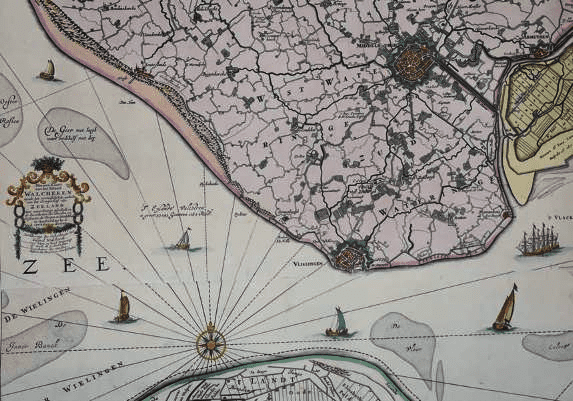
Oil on canvas, 83.2 x 111.8 cm.
Signed lower centre right : J.C. SCHOTEL
Provenance:
United Kingdom, private collection
In this Dutch coastal scene, a sloop, a wide-hulled, low-draft boat with two sails, is bringing in the sails. A two-master, a ‘snauwschip’ lies at anchor in the middle of the composition. A group of figures is placed in the typical dunes of Holland. This beach scene with the port of Vlissingen in the background is seen from the ‘Knollendijk’. The Kenau Hasselaar lunette or Fort des Dunes is depicted on the far left. The skyline of Vlissingen with the spires of the Sint Jacobskerk and the Kleine or Middelkerk is located in the centre. The shellproof barrack or Caserne Cavalier is situated next to the prison tower on the far right.
There is a drawing of quite similar view of Vlissingen in Dordrechts Museum, Netherlands. J.C. Schotel presumably made this drawing on one of his many journeys. In a preliminary drawing in the Amsterdam Museum, Fort Kenau Haselaar is already depicted in the dunes on the left. In both drawings, only a few details are different from the painting, which was consistent with the custom of the day
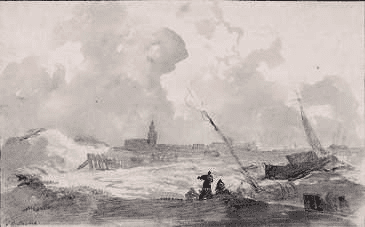
Johannes Christiaan Schotel
View on Vlissingen
Pen in brown on paper
Dordrecht, Dordrechts museum, inv. no. DM/960/T173
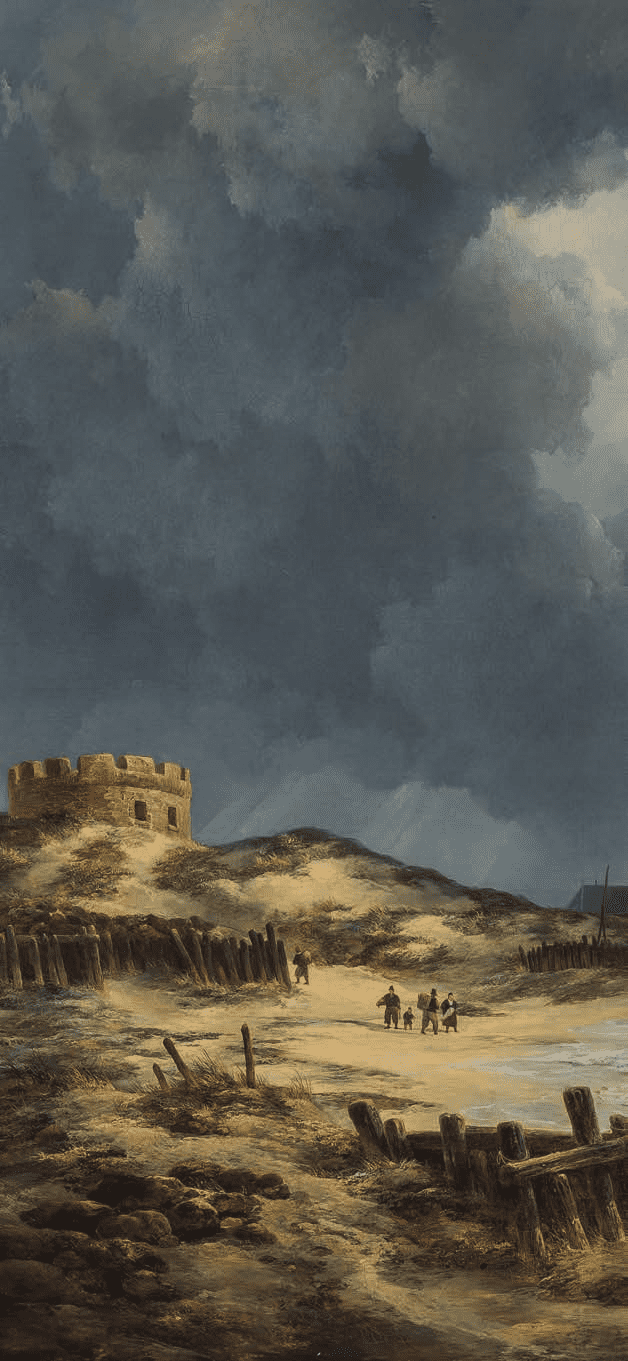
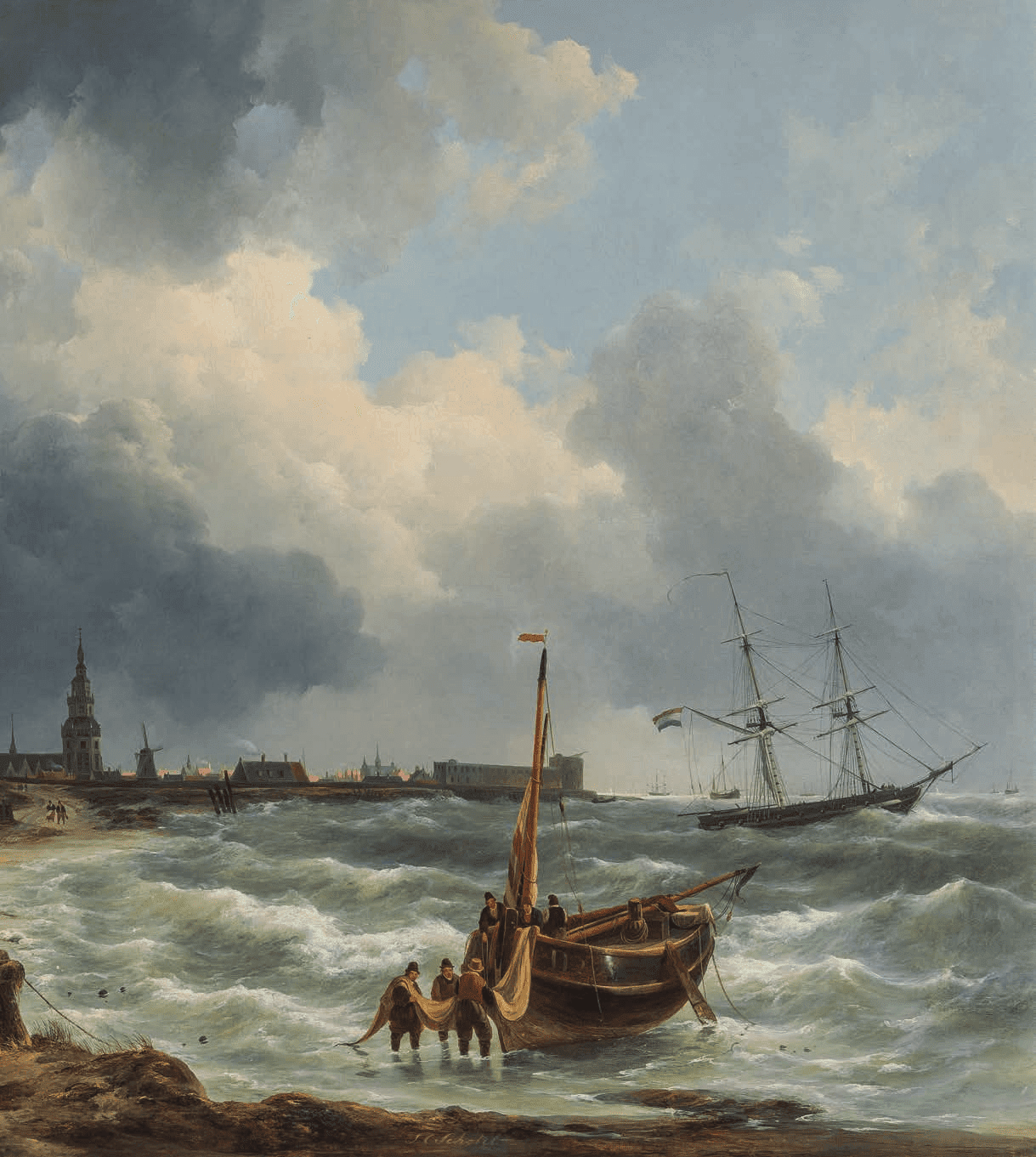
Oil on panel, 65.1 x 90.7 cm
Signed lower left: J.C. SCHOTEL
Provenance:
United kingdom, private collection
The Dordrecht marine painter J.C. Schotel was renowned for his impressive skies and waters. His eminent clients included the Dutch Royal family. In 1829, Schotel was commissioned by William I’s wife Wilhelmina of Prussia to paint a view of the beach at Scheveningen seen from the royal pavilion. His rough seas appealed to the Prince of Orange – the later King William II. The Prince even gave his brother-in-law Nicholas I, the later Tsar, a painting by Schotel as a present. Nicholas was delighted with this gift and later commissioned a couple of paintings from the Dordrecht master, among which was – again – a view of the beach at Scheveningen. The latter painting is a view during a tempest, since turmoil was probably thought to reflect the Russian soul.
Literature:
G.D.J. Schotel, Leven van den zeeschilder J.C. Schotel, Haarlem 1840; J. Erkelens ed., exh..cat.. Tussen zonnegoud en kaarslicht. Dordtse meesters 1780-1840, Dordrecht 1986, p. 94-101; Nelly de Zwaan, Nederland uit de kunst. 365 dagen kijken en lezen, Warnsveld 2005, 3rd of May (ill.).
An early and beautiful beach scene by J. C. Schotel on oak panel dated c 1820. Two drawings of the present composition are preserved, one in the Teylers Museum, Haarlem, the other in The Hague municipal archives. A later, different version on mahogany panel was made frequently by the artist.
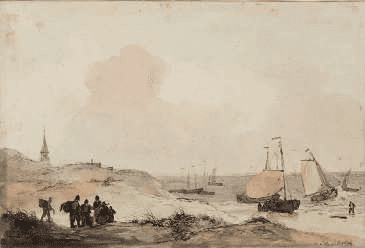
Johannes Christiaan Schotel
A preliminary drawing for Unloading the catch on the beach
of Scheveningen
Pen in brown, brush in color; framework: pen in brown
Gemeente archief Den Haag, inv. no. HGA004111621
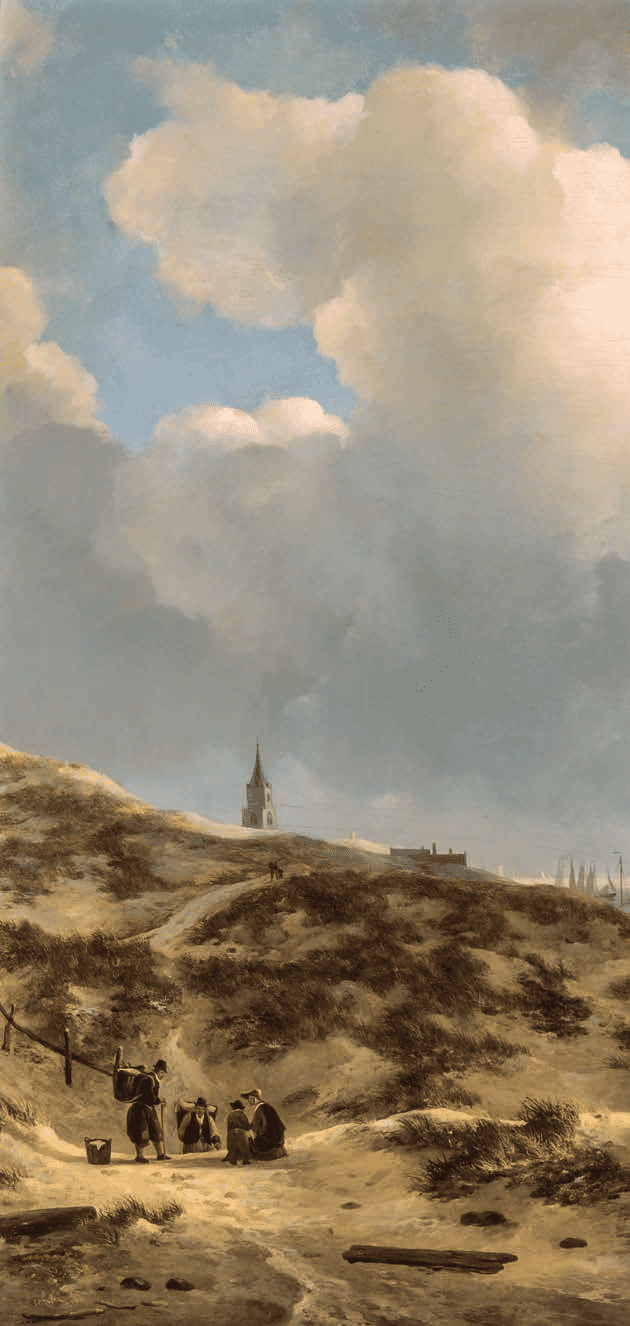
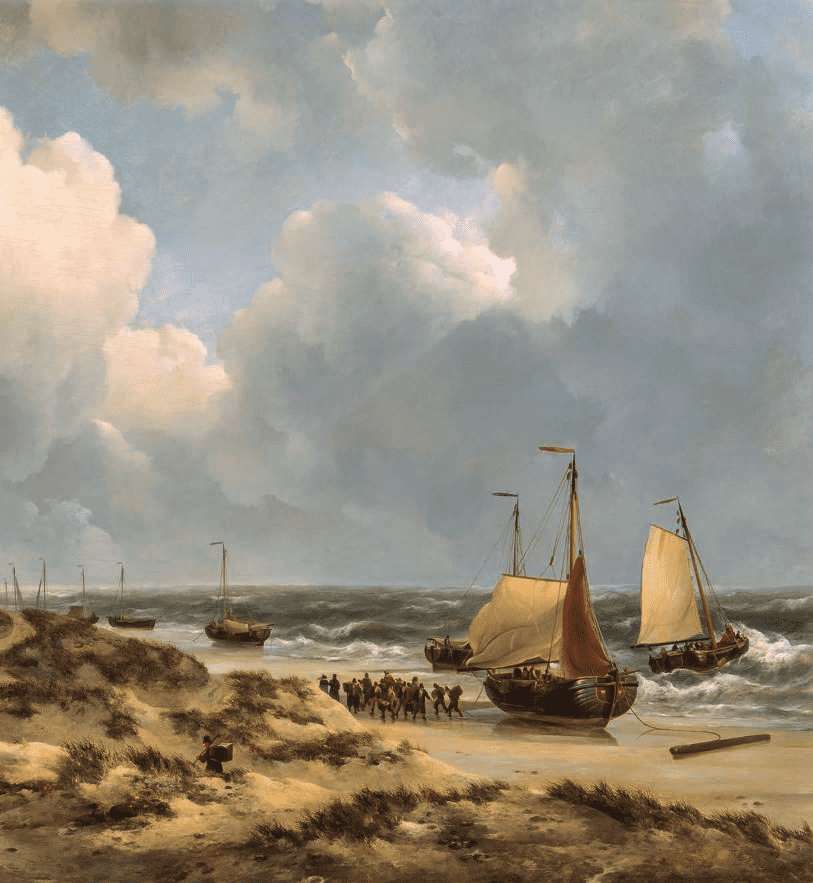
ACKNOWLEDGEMENTS
Production and research Rob Kattenburg
Text Saskia Kattenburg
Printing Die Keure, Bruges
Typesetting Holger Schoorl
Photo credits
pp. 6-7, 8-9, 10-11 and cover, Pieter de Vries, Texel
p. 2 Dordrecht, regionaal archief
p. 2 Haarlem, Teylers museum
p.8 Dordrechts museum
p. 10 Gemeente archief Den Haag
This catalogue is published by Rob Kattenburg BV, 2018
Rob Kattenburg
Eeuwigelaan 6
1861 CM Bergen (NH)
The Netherlands
Tel. +31 (0)72 589 50 51
Fax +31 (0)72 581 6031
[email protected]
www.robkattenburg.nl
By appointment only
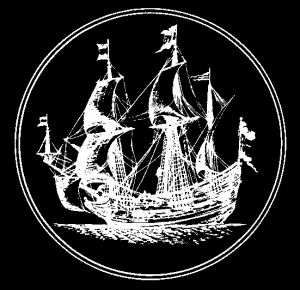
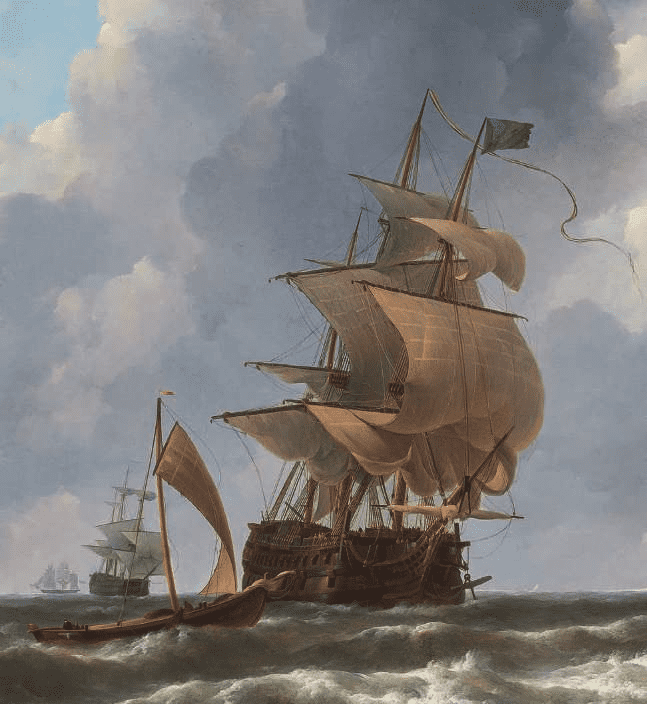
Oil on panel, 67.5 x 97.5 cm.
Signed on the barge : J.C. SCHOTEL
Provenance:
Netherlands, private collection
There is a lot of shipping activity on the choppy waters of the North Sea and the Westerschelde off the important port of Vlissingen. A man-of-war takes in the sails prior to arrival at the port. The warship flies the pennant at the main, which indicates that the commander of a squadron is aboard the ship. In the centre at a distance a barquentine leaves port. A Dutch States yacht is shown in the centre of the picture in stern and starboard-quarter view, towing a ship’s boat bearing the painter’s signature.
The painting may have been commissioned by an official body with maritime interests in Flushing.
The port of Vlissingen (Flushing) can be seen in the distance with on the far left the Kleine or Middelkerk and the prison tower. In the centre is the Keizersbolwerk, a fortification built in 1548, which was expanded in the French-Batavian era when it took on its current form. The stronghold included the Waterpoort, or water gate – a fortified gate, leading directly from the town wall to the quay. It enabled people and supplies to reach the fortification directly from the water and allowed those inside the fortification direct access to water transport.
At that time the bulwark consisted of a round bastion with a gate that gave access to the city. From this water gate, Emperor Charles V left Dutch territory on 15 September 1556 to settle in Spain forever. A few years later (1559) his son and successor Philips II also left for Spain from Vlissingen Waterpoort.
The word ‘yacht’ derives from the Dutch verb jagen or the expression jacht maken, which mean to hunt or to pursue. This light, fast sailing vessel first appeared in the sixteenth century and was used by sailors from Dunkirk, Zeeland and Holland. These armed yachts were used to intercept
larger and slower ships and were the precursors of the yachts that were permanently equipped for war. Its all-round usefulness meant that the yacht was used to deliver messages, convey commands and transport dignitaries.
In the seventeenth century this type of yacht developed into much bigger vessels and some could be even more than a hundred tons. Soon afterwards they were divided into lighter and heavier ships. We can subdivide the different types of yachts that were used by the VOC (Dutch East India Company) and the WIC (Dutch West India Company), which were also used to sail to the Eastand Westindies, the ones that were also part of the war fleet and the ‘Statenjacht’ or States Yacht.
The States Yacht was the general name for yachts used to transport dignitaries, such as princes, hence the name ‘Prinsenjacht’. During the reign of the Stadhouders, the ‘Prinsenjacht’ was a service vessel for the performance of their duties and was owned by the admiralty. The same type was soon used by the members of the Admiralties, the States, the City Councils, the VOC, the WIC and so on. There were ‘Adviesjachten’, ‘Stadsjachten’ ‘Speeljachten’ and ‘Herenjachten’. During the seventeenth century the yacht became a pleasure craft, initially used by royalty and later by the burghers on the canals and the protected and unprotected waters of the Low Countries.
These vessels were usually elaborately decorated with sculptures, paintings and gilding following the tradition of the great sailing ships. In the eighteenth century the ‘Statenjacht’ was also used as a pleasure craft.
In this painting by J.C. Schotel the beautifully decorated ‘Statenjacht’ from around 1840 is shown on the waters of the North Sea, approaching Vlissingen harbour. The ‘Statenjacht’ is prominently flying the tricolour at its stern and is surrounded by a range of typical Dutch vessels.
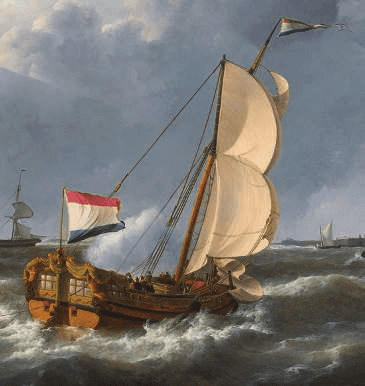
Johannes Christiaan Schotel
Detail of A States Yacht with a Men o’ War in the background,
off the port of Vlissingen
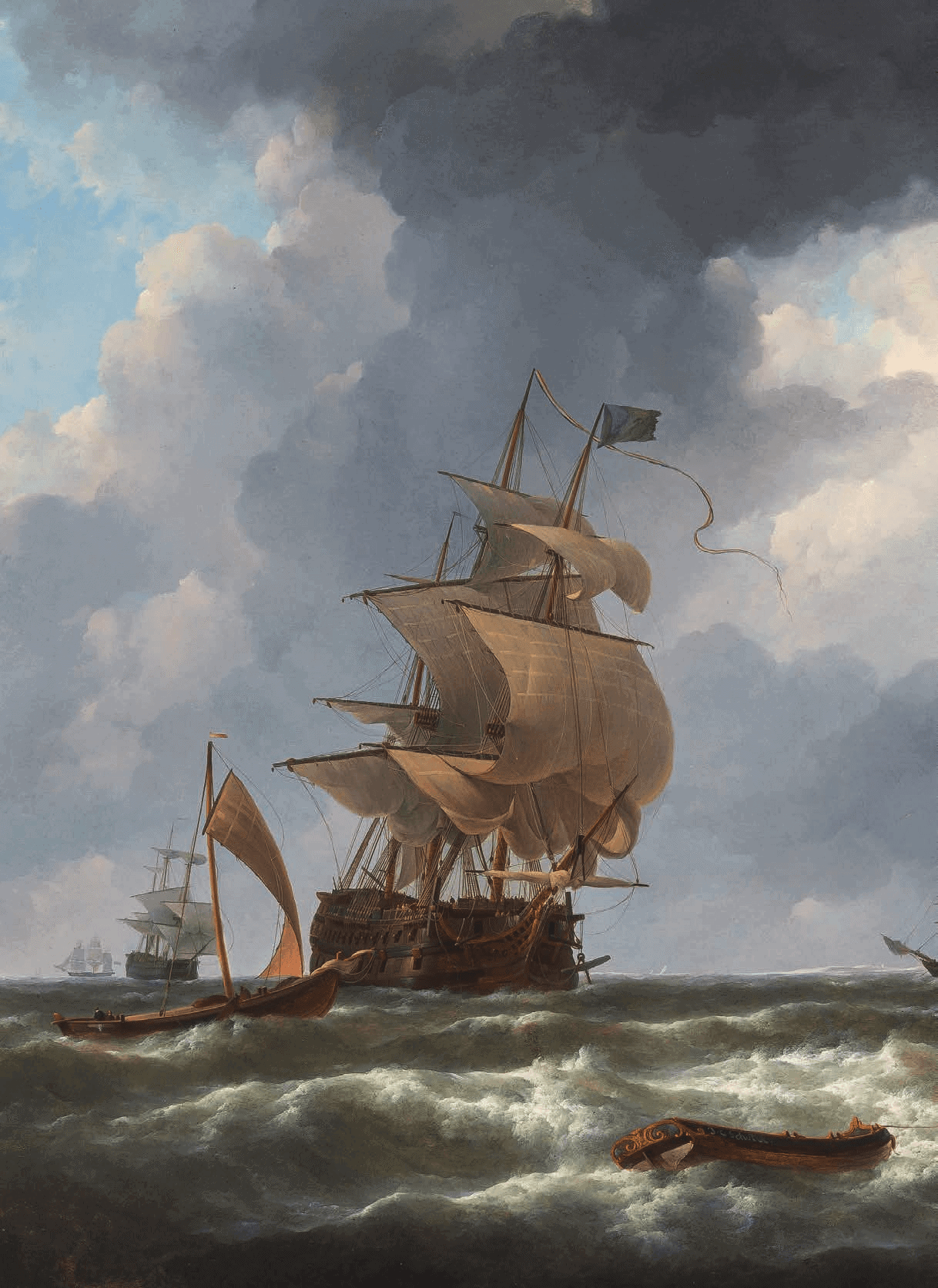
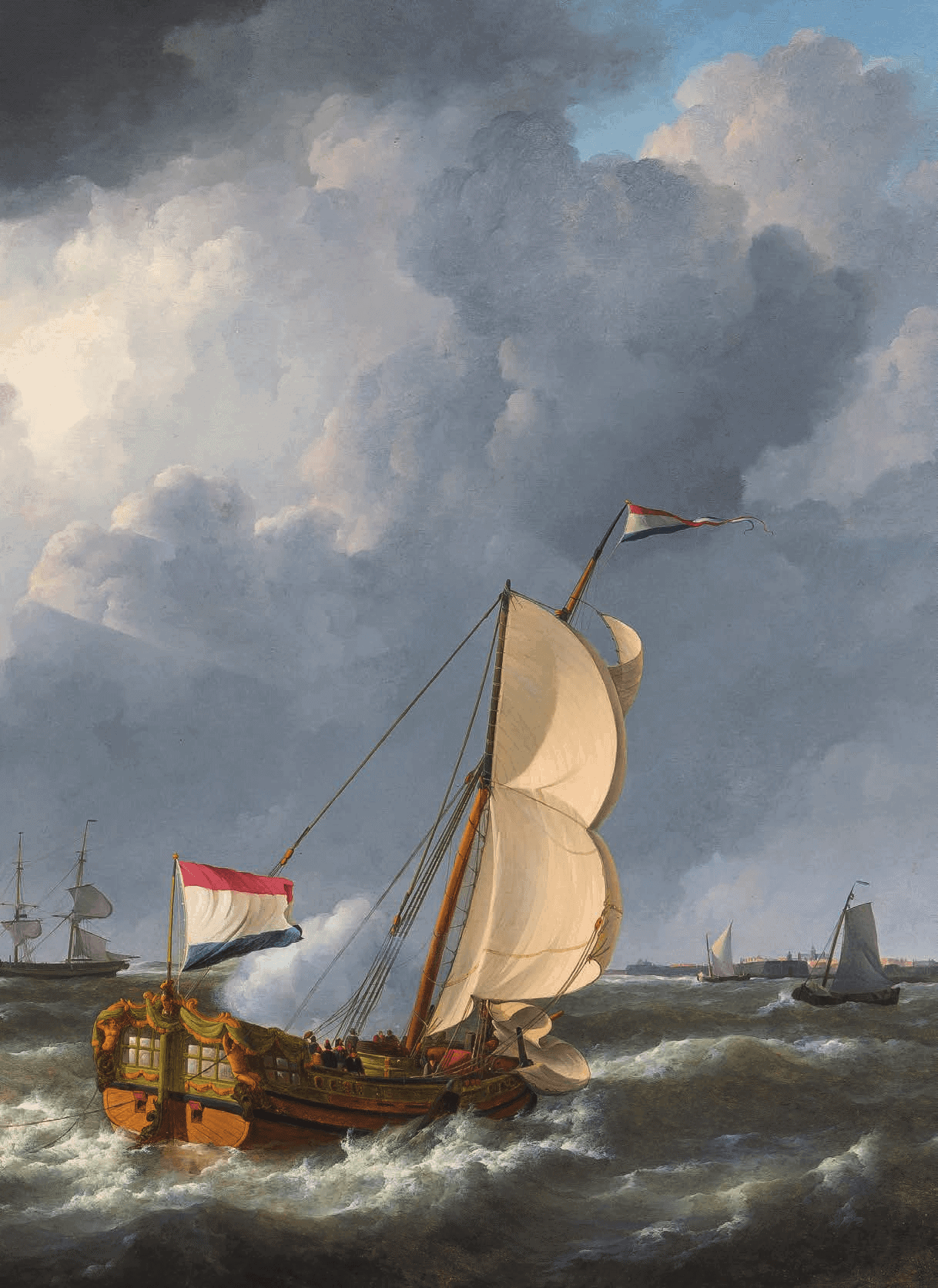
© 2022 Rob Kattenburg
Website Mediya.nl